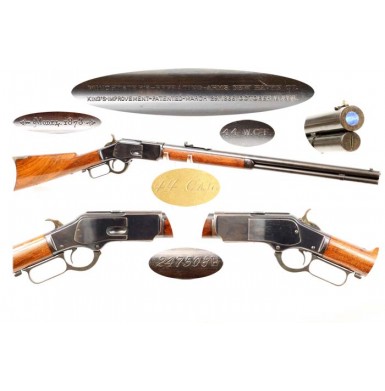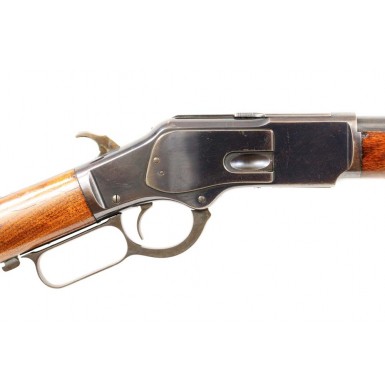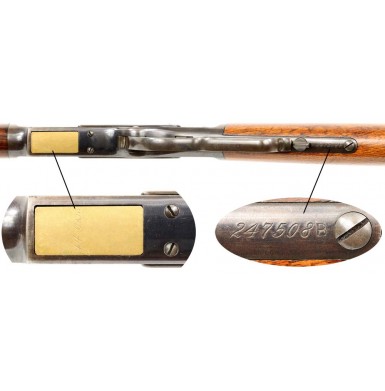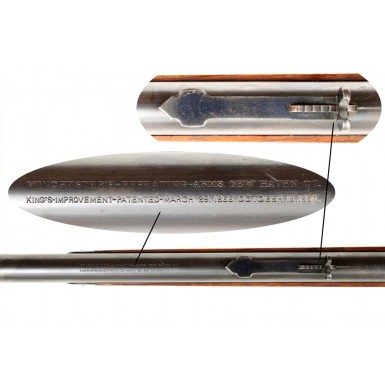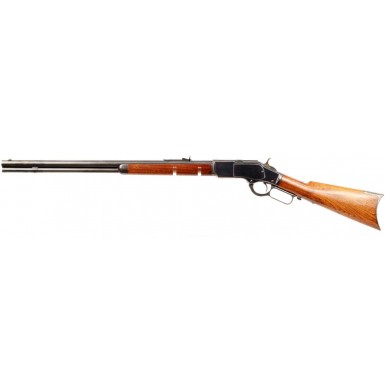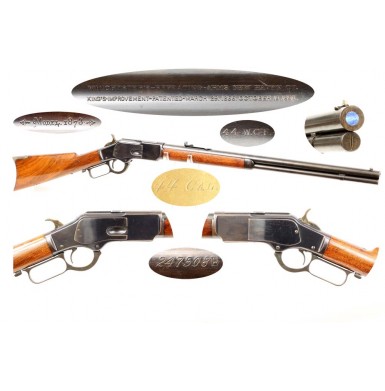Investment Grade Winchester M-1873 Rifle
- Product Code: FLA-3320-SOLD
- Availability: Out Of Stock
-
$1.00
The Winchester Model 1873 is often referred to as “the gun that won the west”, and while the huge numbers produced and the overall popularity of the model in the American West may suggest there is some truth in that statement, it is in all reality hyperbole. Introduced in 1873, the Model 1873 was a significant improvement on the earlier Winchester Model 1866. The primary improvements revolved around the introduction of a reloadable centerfire cartridge, the Winchester .44 Center Fire (better known as the .44-40 or the .44 WC). The introduction of center fire primers and brass cases had allowed some of the inherent limitations of the earlier self-contained ammunition to be reduced. The Henry Rifle, and the 1873s direct predecessor the Model 1866, had fired the .44 Henry Rimfire Flat cartridge. It was a rimfire ignition, copper cased cartridge that used a 200-grain bullet backed by 26 to 28 grains of black powder, generating a velocity of about 1,125 ft/s and a muzzle energy of about 568 ft/lbs. The new .44-40 was brass cased, center fire, reloadable and pushed that same caliber 200 grain bullet to velocities around 1,250 ft/s using a charge of 40 grains of black powder. The roughly 11% increase in velocity allowed the new cartridge to increase the muzzle energy of the bullet to about 688 ft/lbs., or about 21%. This is a fine example of the physical formula (Energy equals Mass times Velocity squared). Thus, a small increase in speed offered a much greater increase in energy. The introduction frame of forged iron (later forged steel), rather than the 1866’s brass frame, provided greater strength and less weight for the M-1873s. The Model 1873 remained in production for just under a half century, from 1873 to 1919, and during that time some 720,610 arms were produced in a dizzying array of configurations and variations. However, in simple terms the gun was available in carbine, rifle and musket models, with the “standard” barrel lengths being 20”, 24” and 30” respectively, with full length magazines standard on all models. Of course, custom barrel lengths, as well as custom magazine lengths, sights, features and finishes were always available at additional cost. Typically barrel lengths could be increased in 2” increments and from a practical standpoint anything that the Winchester gunsmiths and artisans could do, could be ordered as long as the buyer was willing to pay for the enhancements. The Model 1873 went through three major “model” improvements during its lifetime, designated by collectors as 1st Model, 2nd Model and 3rd Model. Most of these changes were relatively minor in terms of the actual operation and functionality of the weapons, with small manufacturing changes to the lever, trigger and hammer mounting, dust cover and dust cover rails being typical of the improvements. Detailed analysis of these modifications can be found in the exhaustive study, The Winchester Book by George Madis. From a collector standpoint, more important evolutionary changes were the introduction of new calibers, including the .38-40 (1879) and the .32-20 (1882). Slightly less than 20,000 M-1873s were also produced in .22 RF. Despite the overwhelming commercial success of the Model 1873, it was military the possibility of contracts that had actually driven Winchester to develop the model. An experimental US military trials rifle, produced by Winchester in 1871 had evolved into the Model 1873, and well into the twilight of the model’s lifetime, Winchester continued to offer a militarized version of the M-1873. The “Musket” version of the Model 1873 came standard with a 30” round barrel and a 27” magazine tube which were secured to the forend with three barrel bands. The musket was also equipped with a combination front sight/bayonet stud to accept an angular socket bayonet. Sling swivels were also provided, one located on the upper barrel band and one in the toe of the stock. Although Winchester doggedly attempted to secure US military contracts for their design, it was universally felt within the US military that the .44-40 cartridge was underpowered and not suitable for military use. This is somewhat interesting, as the during the Civil War, the Henry Rifle, essentially the grandfather of the M-1873, saw some use and acquisition by the US Ordnance Department, and its cartridge (as noted above) was about 11% slower and 21% less powerful than the .44-40. However, by comparison to the newly adopted .45-70 Government cartridge, whose carbine loading pushed a 405-grain bullet at around 1,390 ft/s with a muzzle energy of about 1,798 ft/lbs., the .44-40 was really a pip-squeak pistol strength cartridge. However, a number of foreign countries felt that the rate of fire of the Model 1873 overcame any issues with cartridge performance, and Winchester found a small market for their musket overseas. Most customers were plenty satisfied with the .44-40 as well, and about 80% of all Model 1873 production was in that caliber. The greatest popularity for the Model 1873 Musket was found in South American countries, where the guns were acquired by government and rebel forces alike during the latter part of the 19th and early 20th centuries, as many of these newly independent countries dealt with internal power struggles. The rifle and carbine, however, proved to be the stars of the Winchester Model 1873 product line, with some 58.4% of production being rifles, 36.6% being carbines and only 5% being muskets. Of the rifle production, the large majority were standard length (24”) octagonal barrels with only 1 in 6 rifles (about 16.6%) being produced with round barrels. Standard finish was blued frames, barrels and magazine, with color case hardened levers, hammers and crescent buttplates. Case hardened frames could be custom ordered. Open “sporting” sights were standard, but a wide array of special sights, including various tang-mounted peep sighs were available. After the initial production, it was standard for the .38 and .44 rifles to have a trapdoor in the butt to accept a multi-piece steel cleaning rod. Straight grained walnut was the standard wood for stocks and forend, usually oil finished, but sometimes varnished. As with all other features, stock up grades could be had at an additional cost, including pistol grips, checkering and high grade fancy wood in 2X, 3X or even more exotic, if the buyer’s wallet allowed. Most of the
Offered here is an EXCELLENT condition example of a 3rd Model Winchester M-1873 Rifle. The gun is in the less common “standard” rifle configuration with 24” round barrel rather than the more common octagonal barrel. The rifle is serial number 247508, placing its production in 1887, a year Winchester produced 32,984 Model 1873s of all configurations. The serial number is stamped into the rear of the trigger tang in italic numbers, followed by the Winchester factory work mark B, which is not part of the serial number. The bottom of the brass cartridge lifter is stamped 44 CAL., also in italics, and the top of the barrel, just in front of the receive is stamped 44 W.C.F. as well. The upper tang is marked with the standard mid-production MODEL 1873 mark, flanked by a pair of foliate sprays. The top of the barrel is marked with the usual mid-production two-line address and patent information and reads:
WINCHESTER,S-REPEATING-ARMS NEW HAVEN CT.
KING,S-IMPROVEMENT-PATENTED-MARCH 29, 1866. OCTOBER 16, 1860.
The 3rd Model Winchester Rifle offered here is in about EXCELLENT condition overall. Conservatively, the gun retains about 90%+ of its original blued finish. Some of the finish has dulled and faded slightly and mixed with a lightly oxidized plum brown patina, giving the gun the appearance of even more finish than it actually retains. The receiver retains the majority of its original bright blue, at least 90%+, with most of the loss due to high edge wear at the edges of the flats, some fading from handling and use and a number of small surface scuffs around the loading port from the insertion of ammunition. There is some finish loss along both the upper and lower tangs, exactly the places where the rifle was handled and held the most, and in those areas the loss is due to rubbing, resulting in thinning and dulling, and leaving a mostly smoky blue-gray color with strong traces of the original blue. The hammer retains the large majority of their its original brilliant case-hardened finish, approaching 85%-90% as well. The lever has faded and dulled significantly more than the hammer and only retains about 40% case coloring, most of which has a darker, mottled tobacco patina, rather than the vivid color seen on the hammer. The buttplate has faded significantly as well, retaining 30%-40% of its case color. Most of it is in the form of dull mottling with a bluish-gray patina, and with a thumb sized splotch of minor oxidation on the bottom near the upper point of the crescent. The barrel retains about 85%+ of its bright original blue, which is starting to dull slightly and fade in places from handling and use, with some flecks of light surface oxidation are scattered along the barrel, shot through the blue. There are some lightly scattered areas of very minor surface oxidation present on the barrel, along with some tiny areas of oxidized roughness. The only really notable one is a thumb-sized patch on the reverse of the barrel, about 2 ““ from the muzzle. The reverse also shows an area about a 5”-6” long on the side of the barrel where the finish has visible thinned and worn, possibly from the rifle being carried in a saddle scabbard. There are a few scattered flecks of minor pinpricking here and there, and some pinpricking at the face of the muzzle, but otherwise the barrel and magazine tube remain in wonderful condition with nearly all their original finish present. The brass cartridge lifter has a pleasing, mellow mustard patina. The bore of the rifle is in about VERY FINE+ condition and remains nearly mirror bright. The rifling remains extremely crisp, and the bore shows only some frosting in the grooves along its length, as well as some lightly scattered pinpricking, with a few minor spots of darker oxidation present. The original standard rifle pattern rear sight is in place, as is the standard dovetailed front sight German silver blade insert. The original 3rd model dust cover and integral rails are in place on the top of the receiver and the dust cover operates smoothly. The dust cover shows some fading and wear to the finish from handling and use. The original trapdoor that conceals the recess in the buttstock where the cleaning rods are stored is in place and is fully functional, but the rods are missing. The rifle is mechanically EXCELLENT and remains in sound condition. The action works smoothly, with the lever, bolt and lifter all working exactly as they should. The stock and forend are in about VERY FINE+ condition. They are both solid and complete and free of any breaks, or repairs. Both show some scattered minor bumps, dings, mars and a couple of scratches from storage, use and transport, but no serious abuse. Neither shows any indication of having been sanded or refinished in any way. There is one tiny, about ““ long, surface grain crack at the rear of the lower reverse of the tang that is nearly invisible, and that I only noticed while editing the photos for the web site. It is really not even worth mentioning, but in the spirit of full disclosure and accurate description, I have noted it hear. The wood to metal fit remains quite good throughout, and the condition of the stock and forend match the balance of the rifle very well.
Overall this is an outstanding and extremely attractive example of a 3rd Model Winchester M-1873 Rifle. With round barreled rifles representing only 1 in 6 (16.6%) of total Model 1873 rifle production, they are fairly rare in the greater scheme of 1873 collecting. For any serious Winchester collector, a round barreled 1873 rifle must be displayed along with the more commonly encountered octagon barreled rifle. In fact, the round barreled 1873 rifle represents less than 10% of total Winchester 1873 production. This gun was made during the final push of westward expansion, and could well have been witness to the last days of the American “Wild West”. While the gun shows some light wear from actual use, it was clearly always well cared. With so many of the high-grade Winchesters being offered for sale these days having been “worked on”, “helped” or “restored”, it nice (and rather difficult) to find a completely honest gun that has not been “enhanced” at any point during its lifetime. This rifle remains an outstanding, completely honest and investment grade example of a scarce variant of the classic Model 1873 rifle, the “gun that won the west”.
SOLDTags: Investment, Grade, Winchester, M, 1873, Rifle

